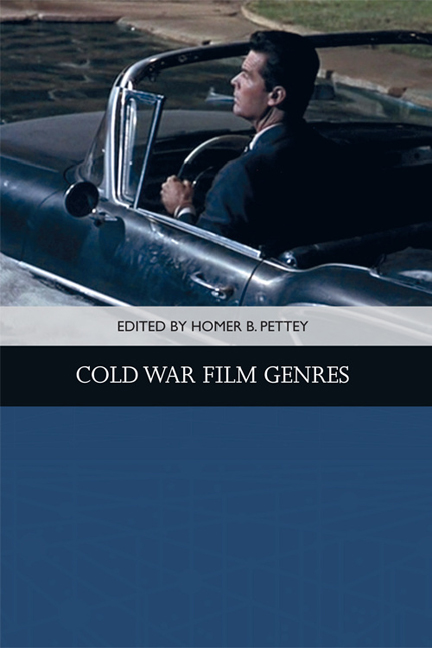Book contents
- Frontmatter
- Contents
- List of Illustrations
- Acknowledgments
- Notes on the Contributors
- 1 Introduction: Cold War Genres and the Rock-and-Roll Film
- 2 Social Factors in Brainwashing Films of the 1950s and 1960s
- 3 The Berlin Crisis? Piffl!: Billy Wilder’s Cold War Comedy, One, Two, Three
- 4 The Small Adult Film: A Prestige Form of Cold War Cinema
- 5 “I’m Lucky – I Had Rich Parents”: Disability and Class in the Postwar Biopic Genre
- 6 Rogue Nation, 1954: History, Class Consciousness, and the “Rogue Cop” Film
- 7 Internal Enmity: Hollywood’s Fragile Home Stories in the 1950s and 1960s
- 8 Suburban Sublime
- 9 Domestic Containment for Whom? Gendered and Racial Variations on Cold War Modernity in the Apartment Plot
- 10 Success and the Single Girl: Urban Romances of Working Women
- 11 Paris Loves Lovers and Americans Loved Paris: Gender, Class, and Modernity in the Postwar Hollywood Musical
- 12 Straight to Baby: Scoring Female Jazz Agency and New Masculinity in Henry Mancini’s Peter Gunn
- Index
9 - Domestic Containment for Whom? Gendered and Racial Variations on Cold War Modernity in the Apartment Plot
Published online by Cambridge University Press: 24 April 2021
- Frontmatter
- Contents
- List of Illustrations
- Acknowledgments
- Notes on the Contributors
- 1 Introduction: Cold War Genres and the Rock-and-Roll Film
- 2 Social Factors in Brainwashing Films of the 1950s and 1960s
- 3 The Berlin Crisis? Piffl!: Billy Wilder’s Cold War Comedy, One, Two, Three
- 4 The Small Adult Film: A Prestige Form of Cold War Cinema
- 5 “I’m Lucky – I Had Rich Parents”: Disability and Class in the Postwar Biopic Genre
- 6 Rogue Nation, 1954: History, Class Consciousness, and the “Rogue Cop” Film
- 7 Internal Enmity: Hollywood’s Fragile Home Stories in the 1950s and 1960s
- 8 Suburban Sublime
- 9 Domestic Containment for Whom? Gendered and Racial Variations on Cold War Modernity in the Apartment Plot
- 10 Success and the Single Girl: Urban Romances of Working Women
- 11 Paris Loves Lovers and Americans Loved Paris: Gender, Class, and Modernity in the Postwar Hollywood Musical
- 12 Straight to Baby: Scoring Female Jazz Agency and New Masculinity in Henry Mancini’s Peter Gunn
- Index
Summary
An apartment plot is a film in which the apartment figures as a central device. This means that the apartment is more than setting but motivates or shapes the narrative in some key way. Famous apartment plots include Rear Window (Hitchcock, 1954), In a Lonely Place (Ray, 1950), An American in Paris (Minnelli, 1951), How to Marry a Millionaire (Negulesco, 1953), Pillow Talk (Gordon, 1959), Bells are Ringing (Minnelli, 1960), Barefoot in the Park (Saks, 1967), Wait Until Dark (Young, 1967), The Odd Couple (Saks, 1968), and Rosemary's Baby (Polanski, 1968). Though none of these films is typically taken to be reflective of the Cold War – In a Lonely Place might be an exception in its depiction of paranoia and friends distrusting friends – this chapter discusses the apartment plot as a Cold War genre.
My book, The Apartment Plot: Urban Living in American Film and Popular Culture, 1945 to 1975 argued for an understanding of the apartment plot as genre and, without naming it as a Cold War genre, focused on films made within the Cold War era. Yet, the apartment plot is not invented in 1945 and is not exclusive to the American context. In Apartment Stories: City and Home in Nineteenth-Century Paris and London, Sharon Marcus locates a cycle of apartment plots in nineteenth-century British and French novels. In film, Abram Room's Bed and Sofa (1927) offers an early Russian apartment plot in which a housing shortage leads to an adulterous ménage à trois. Hands Across the Table (Leisen, 1935) shows two gold-diggers – one female (Carole Lombard) and one male (Fred MacMurray) – sharing quarters while each searches for a rich prospect. Early musicals, such as Sunny Side Up (Butler, 1929) and Gold Diggers of 1933 (Berkeley, 1933), revolve around female apartment roommates who date and marry rich men. The genre includes art cinema films such as Ali: Fear Eats the Soul (Fassbinder, 1974) and Jeanne Dielman, 23 Quai du Commerce, 1080 Bruxelles (Akerman, 1975). And the apartment plot extends well beyond the Cold War era, notably in television shows such as Three's Company (1977), Seinfeld (1990), Melrose Place (1992), Frasier (1993), Friends (1994), Will and Grace (1998), Two and a Half Men (2003), How I Met Your Mother (2005), Rules of Engagement (2007) and Don't Trust the B— in Apt. 23 (2012).
- Type
- Chapter
- Information
- Cold War Film Genres , pp. 163 - 180Publisher: Edinburgh University PressPrint publication year: 2018



